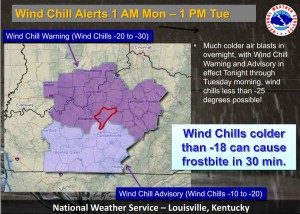County under Wind Chill Warning as Arctic air descends on Central Kentucky

Click map to enlarge (a new window will open).
STAFF REPORT
Monday, Jan. 6, 2014, 12:15 a.m. — Nelson County is under a Wind Chill Warning through 1 p.m. Tuesday, Jan. 7, 2014.
A Wind Chill Warning means that a combination of very cold air and strong winds will create dangerously low wind chill values now through Tuesday afternoon of 20 to 30 degrees below zero. These wind chills may quickly result in frost bite to unprotected skin and hypothermia or death if precautions are not taken.
Accumulations of snow overnight of about an inch are expected. The strong winds and low temperatures will result in wet roadways freezing and create the potential for extremely hazardous road conditions.
The county is also under a Winter Weather Advisory through 6 a.m. Monday, Jan. 6. A Winter Weather Advisory means periods of snow may cause travel difficulties and contribute to hazardous road conditions.
Cold Weather Precautions
Make sure you always have a well-stocked Winter Home Emergency Supply Kit that includes flashlights, portable radio, extra batteries, a first aid kit, bottled water, non-perishable food and a manual can opener.
Minimize outside activities, particularly the elderly and very young. Also, consider your pets.
Dress in several layers of loose-fitting, lightweight clothing, rather than a single layer of heavy clothing. Outer garments should be tightly woven and water repellent. Wear a hat, mittens and sturdy waterproof boots, protecting your extremities. Cover your mouth with a scarf to protect your lungs.
Excessive exposure can lead to frostbite, which is damaging to body tissue that is frozen. Frostbite causes a loss of feeling and a pale appearance in extremities, such as fingers, toes, ear lobes or the tip of the nose. If symptoms are detected, seek medical help immediately.
Hypothermia can occur in extreme cases. The warning signs are uncontrollable shivering, memory loss, disorientation, incoherence, slurred speech, drowsiness and apparent exhaustion. If the person’s temperature drops below 95 degrees, seek immediate medical care.
When utilizing alternate heating sources, such as your fireplace, wood stove or space heater, take the necessary safety precautions. Keep a fire extinguisher handy; ensuring everyone knows how to use it properly. Test smoke alarms and Carbon Monoxide (CO) detectors.
If you lose your heat, seal off unused rooms by stuffing towels in the cracks under the doors. At night, cover windows with extra blankets or sheets.
Food provides the body with energy for producing its own heat.
Be a good neighbor. Check with elderly or relatives and friends who may need additional assistance to ensure their safety.
To keep pipes from freezing, wrap them in insulation or layers of newspapers, covering the newspapers with plastic to keep out moisture. Allow a trickle of warm water to run from a faucet that is farthest from your water meter or one that has frozen in the past. This will keep the water moving so that it cannot freeze. Learn how to shut off your water if a pipe bursts.
If pipes freeze, remove insulation, completely open all faucets and pour hot water over the pipes or wrap them with towels soaked in hot water, starting where they are most exposed to the cold. A hand-held hair dryer, used with caution, also works well.
-30-








